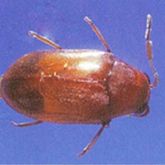Queensland pine beetle

Adult Queensland pine beetle
© Queensland Government

Timber showing small exit holes, caused by the Queensland pine beetle
© Queensland Government
Native to Queensland, the small Queensland pine beetle is a pest of some native softwood timbers. It burrows into timber, creating a network of tunnels, which over time weaken timber and timber buildings.
Improved building practices for timber constructions have reduced the risk of attack and reports of damage.
Scientific name
Calymmaderus incisus
Similar species
- Cigarette beetle (Lasioderma serricorne)
- Common furniture beetle (Anobium punctatum)
- Pine bark anobiid (Ernobius mollis)
- Powderpost beetle (Lyctus species), but this beetle's frass is soft and silky when rubbed in the hand rather than gritty
Description
- Adult beetles are oval-shaped, about 3mm long, 1.5mm wide and shiny reddish-brown.
- Antennae have a 3-segmented club on the end.
- Body surfaces are covered in fine hairs and many very small punctures, which are not visible to the eye.
- Legs are often folded tightly against the body.
- Eggs are white, spherical, 0.4mm in diameter and just visible.
- Larvae are soft, covered with many fine hairs, curved, wrinkled, and creamy white with dark-brown jaws.
- Fully grown larva measures 4–5mm long and 1.5mm wide.
- Pupa is soft, oval and creamy white and measures 3.0–3.5mm long and 1.5mm wide.
Distribution
- Widespread in south-eastern Queensland
- Significant damage to timbers within the area bounded by Murwillumbah (New South Wales) in the south, Bundaberg in the north and the Great Dividing Range in the west
Hosts
- Hoop pine (Araucaria cunninghamii)
- Bunya pine (Araucaria bidwillii)
- Kauri pine (Agathis robusta)
- Exotic pines (Pinus species) – rarely
- Spotted gum (Corymbia maculata) – rarely
Damage
- Attacks unsealed (not painted or varnished) susceptible wood in housing and sometimes furniture.
- Attacks are most serious in old homes within more densely populated areas.
- Re-infests untreated susceptible timber until it is completely honeycombed and has lost its strength.
- Attacks hoop pine floors and walls, but rarely roofing timbers.
- Typically only attacks some boards or sapwood areas within boards.
- Boards can appear strong from the top but be riddled with holes. underneath, as adults emerge mainly from the underside of floors.
- Circular holes, 2mm in diameter, are created in the timber surface when mature larvae pupate and adults emerge. The exit holes may penetrate paint or wall sheeting.
- Damage progresses slowly so extensive damage may take many years.
- Infestations in very old structures are likely to have died out naturally, when all the susceptible timber was consumed. Painted wallboards often show dimpling but no new holes. This indicates the pest is extinct.
Biology
- Live adults are only found from October to February. They live for up to 4 weeks.
- Around 30 eggs are laid in cracks of susceptible timber and larvae hatch in a few weeks.
- Larvae burrow long distances into the timber to feed (only the larval stage destroys timber).
- Tunnels run with and across the grain, giving a honeycombed appearance.
- Tunnels are packed loosely with fine, gritty frass (cigar-shaped pellets of chewed wood when magnified).
- Frass can be ejected in small amounts through exit holes
- Larvae usually take 3 years to develop.
- Before pupating, the larva moves closer to the surface and constructs a pupal chamber.
- After pupation, adults emerge to mate and live for up to 4 weeks.
Control
- To prevent damage, which is less costly than treating:
- limit insect access to susceptible timber using coverings or enclosures
- paint or polish timber with varnish or wax
- treat timber with a preservative at the source.
- Queensland building regulations contain measures to limit infestations.
- Certain items can be treated using fumigation or freezing, but these methods provide no protection against reinfestation.
- Consult a professional pest control agency for information and advice to manage a suspected infestation.
Resources and research
- Australian Pesticides and Veterinary Medicines Authority (APVMA)
- Peters, BC, King, J, Wylie, FR, 1996, Pests of timber in Queensland, Forestry Research Institute, Brisbane